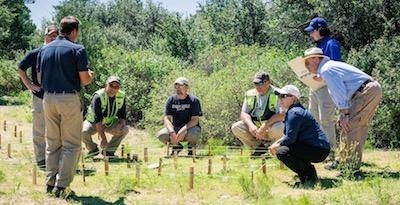Sat, Aug 26, 2017
Research Provided Data From Various Sensors That Can Be Beneficial To First Responders In Accident Situations
Representatives from Embry-Riddle’s Daytona Beach, Worldwide and Prescott campuses teamed up and were joined by members of the NTSB at the Prescott Campus’ Robertson Aircraft Accident Investigation Laboratory earlier this month to conduct field research in the first grant-funded project “Predictive UAS Emergency Management Sensor Detection Analysis and Application.”

Faculty members working on the research (which is funded by the University’s Research and Graduate Studies department led by Dr. Michael Hickey), include Prescott’s Dr. Erin Bowen and Assistant Professor Johnny Young, Worldwide’s Research Chair and Associate Professor Dr. David Ison and Assistant Professor Dr. Sonya McMullen and Daytona Beach’s Assistant Professor Dr. Troy Henderson and Assistant Professor Dr. Richard Prazenica. NTSB investigators Bill English and Michael Bauer were there to examine how to integrate unmanned vehicles into accident investigation. Both the NTSB and Embry-Riddle research teams have agreed to share imaging data collected during this week – which includes studying sensor packages (like infrared) and camera options to aerially scan for various chemicals, heat signatures, metallic or composite fragments and more.
“This research provided us data from various types of sensors that will likely be able to assist first responders and accident investigators. The applications potentially apply to all types of transportation,” said Dr. Ison, who is Principal Investigator on the project. “The NTSB has been very encouraged by our results, and we discovered some interesting applications of sensor data atypical to transportation and observations that we plan to leverage further in future research.”
Also present was Professor of Safety Science and Prescott Crash Lab director Bill Waldock, who was onsite working with a film crew from Discovery Channel Canada.
“Partnering for research across all three Embry-Riddle campuses has been, and continues to be, an outstanding experience. We are combining our respective skills and knowledge in ways even we didn’t anticipate,” said Dr. Bowen, Director of the Robertson Safety Institute and Chair of the Behavioral & Safety Sciences Department at the Prescott Campus. “I think it was this synergy in our collaboration that encouraged the NTSB to connect and come out to our facilities and share their work with us as well. I’m confident this team is going to be working on projects together for a long time.”
(Image provided with ERAU feature story)
More News
"The owners envisioned something modern and distinctive, yet deeply meaningful. We collaborated closely to refine the flag design so it complemented the aircraft’s contours w>[...]
Nonradar Arrival An aircraft arriving at an airport without radar service or at an airport served by a radar facility and radar contact has not been established or has been termina>[...]
From 2022 (YouTube Edition): Still Life with Verve David Uhl was born into a family of engineers and artists—a backdrop conducive to his gleaning a keen appreciation for the >[...]
Also: Electra Goes Military, Miami Air Taxi, Hypersonics Lab, MagniX HeliStrom Amazon’s Prime Air drones are back in the spotlight after one of its newest MK30 delivery drone>[...]
Also: Trailblazing Aviator Betty Stewart, Wind Farm Scrutiny, Chatham Ban Overturned, Airbus Shares Dive A Thunderbird pilot, ID'ed alternately as Thunderbird 5 or Thunderbird 6, (>[...]
 Aero-News: Quote of the Day (12.11.25)
Aero-News: Quote of the Day (12.11.25) ANN's Daily Aero-Term (12.11.25): Nonradar Arrival
ANN's Daily Aero-Term (12.11.25): Nonradar Arrival Classic Aero-TV: David Uhl and the Lofty Art of Aircraft Portraiture
Classic Aero-TV: David Uhl and the Lofty Art of Aircraft Portraiture Airborne-NextGen 12.09.25: Amazon Crash, China Rocket Accident, UAV Black Hawk
Airborne-NextGen 12.09.25: Amazon Crash, China Rocket Accident, UAV Black Hawk Airborne 12.05.25: Thunderbird Ejects, Lost Air india 737, Dynon Update
Airborne 12.05.25: Thunderbird Ejects, Lost Air india 737, Dynon Update



